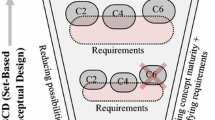Abstract
The presence of immature concepts makes difficult decision making at upstream phase of a development project. Rework tasks in collaborative development projects dealing with immature design concepts are very frequent and are responsible of cost overruns and schedule delays. In addition, decisions taken during conceptual design stage have the most important influence on product life cycle cost. In this context, a useful practice is to develop two or more concepts in parallel and delay decision making. Even so, a first screening of concepts is usually needed because of the substantial resources and time required in development phase. In this paper, an approach of concepts screening is proposed at conceptual design phase on the basis of two metrics. The first assesses ability of concepts to meet requirements with integration of maturity. Fuzzy logic tools are used to capture and propagate imprecision in embodiment design choices and behavior models. The second metric aims to assess expected performance of novel concepts compared with an existent product. It uses generalized ordered weighted averaging operator. A parametric aggregation function is also proposed as a support when using the two metrics. The proposed approach was applied to the development of a solar collector.









Similar content being viewed by others
References
Zimmer, L., Zablit, P.: Global aircraft predesign based on constraint propagation and interval analysis. In: Proceedings of CEAS Conference on Multidisciplinary Aircraft design and Optimisation. Kln, Germany (2001)
Morgan, J.M., Liker, J.K.: The Toyota Product Development System: Integrating People. Process and Technology. Productivity, Seattle (2006)
Sobek, D.K., Ward, A.C., Liker, J.K.: Toyotas principles of set-based concurrent engineering. Sloan Manage. Rev. 40(2), 6783 (1999)
Pahl, G., Beitz, W.: Engineering Design a Systematic Approach, 2nd edn. Springer, London (1996)
Ullman, D.G.: The Mechanical Design Process. 3rd edn. McGraw-Hill Higher Education, Manhattan, New York (2003)
O’Brien, C., Smith, S.J.E.: Design maturity assessment for concurrent engineering co-ordination. Int. J. Prod. Econ. 41(1–3), 311320 (1995)
Dunn, J.: Simultaneous engineering side-by-side to success. Engineer 271(7020), 5153 (1990)
Beth, C.M., Konrad, M., Shrum, S.: CMMI for Development: Guidelines for Process Integration and Product Improvement, 3rd edn. Addison-Wesley, Boston, Massachusetts (2007)
Katz, D.R., Sarkani, S., Mazzuchi, T., Conrow, E.H.: The relationship of technology and design maturity to dod weapon system cost change and schedule change during engineering and manufacturing development. Syst. Eng. 18(1), 115 (2014)
Sharif, N., Huang, C.: Innovation strategy, firm survival and relocation: the case of Hong Kong-owned manufacturing in Guangdong Province. China. Res. Policy 41, 6978 (2012)
Guitouni, A., Martel, J.M.: Tentative guidelines to help choosing an appropriate MCDA method. Eur. J. Oper. Res. 109, 501521 (1998)
Collignan, A., Sebastian, P., Pailhes, J., Ledoux, Y.: Arc-elasticity and hierarchical exploration of the neighborhood of solutions in mechanical design. Adv. Eng. Inform. 26, 603617 (2012)
Wood, K.L., Antonsson, E.K.: Computations with imprecise parameters in engineering design: background and theory. J. Mech. Transm-T ASME. 111(4), 616625 (1989)
Zadeh, L.A.: Fuzzy sets. Inform. Control. 8, 338353 (1965)
Okudan, G.E., Tauhid, S.: Concept selection methods a literature review from 1980 to 2008. Int. J. Des. Eng. 1(3), 243277 (2008)
El Amine, M., Pailhs, J., Perry, N.: Selection and use of a multi-criteria decision aiding method in the context of conceptual design with imprecise information: Application to a solar collector development. Concurr. Eng. Res. A. 24(1), 3547 (2016)
Roy, B., Slowinski, R.: Questions guiding the choice of a multicriteria decision aiding method. Eur. J. Decis. Process. 1, 6997 (2013)
Neumann, J.V., Morgenstern, O.: Theory of games and economic behavior. In: Wiley, J. (eds.), pp. 1013. Science editions. Hoboken, New Jersey (1944)
Pahl, G., Beitz, W.: Engineering Design. In: The Design Council. London , pp. 119138 (1984)
Scott, M.J., Antonsson, E.K.: Aggregation functions for engineering design trade-offs. Fuzzy Set Syst. 99(3), 253264 (1998)
Malak Jr., R.J., Aughenbaugh, J.M., Paredis, C.J.J.: Multi-attribute utility analysis in set-based conceptual design. Comp. Aid. Des. 41(3), 214227 (2009)
Roubens, M.: Some properties of choice functions based on valued binary relations. Eur. J. Oper. Res. 40, 309–321 (1989)
Mankins, J.C.: Technology readiness levels (White paper). NASA Advanced Concepts Office, Washington, DC (1995)
Conrow, E.: Estimating technology readiness level coefficients. J. Spacecr. Rockets 48, 146–152 (2011)
Otto, K.N., Antonsson, E.K.: The method of imprecision compared to utility theory for design selection problems. Design Theory and Methodology - DTM’;93. 53, 167–173 (1993)
Vincent, T.: Game theory as a design tool. J. Mech. Transm. Autom. Des. 105(2), 165–170 (1983)
Saaty, T.L.: A scaling method for priorities in hierarchical structures. J. Math. Psychol. 15, 234–281 (1977)
Yager, R.R.: On ordered weighted averaging aggregation operators in multi criteria decision making. IEEE Trans. Syst. Man Cybern. 18(1), 183–190 (1988)
Kumara, V., Shrivastavaa, R.L., Untawaleb, S.P.: Fresnel lens: a promising alternative of reflectors in concentrated solar power. Renew. Sustain. Energy. Rev. 44, 376–390 (2015)
Author information
Authors and Affiliations
Corresponding author
Rights and permissions
About this article
Cite this article
Amine, M.E., Perry, N. & Pailhès, J. A risk-based approach to drive conceptual design taking into account low-maturity products. Int J Interact Des Manuf 11, 677–688 (2017). https://doi.org/10.1007/s12008-016-0354-z
Received:
Accepted:
Published:
Issue Date:
DOI: https://doi.org/10.1007/s12008-016-0354-z




